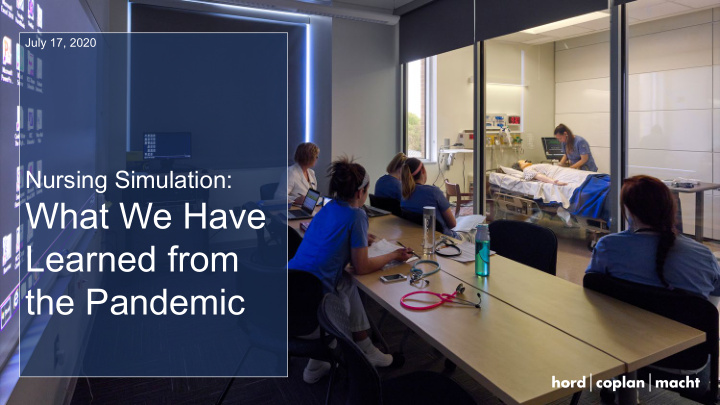



July 17, 2020 Nursing Simulation: What We Have Learned from the Pandemic
NURSING SIMULATION: What We Have Learned from the Pandemic PAMELA R. JEFFRIES CRYSTEL L. FARINA PAUL LUND PAMELA SLAVEN-LEE George Washington University George Washington University Hord Coplan Macht George Washington University School of Nursing School of Nursing School of Nursing KELLIE BRYANT SHARON DECKER CAROL F. DURHAM Columbia University Texas Tech University The University of North Health Sciences Center School of Nursing Carolina at Chapel Hill
A Dean’s Perspective During this unprecedented time teaching, planning, and leading during a global pandemic, these are lessons learned: Pamela R. Jeffries Lesson # 1: The Necessity of Communication and Transparency PhD, RN, FAAN, ANEF Professor and Dean Lesson # 2: The Value of Collaboration George Washington University School of Nursing Lesson # 3: Change can occur quickly when needed Lesson # 4: Greater Possibilities and Opportunities Together Lesson # 5 : Art of creativity and out-of-the-box thinking Lesson # 6: An attitude of gratitude
Timely and Accurate Messaging Mission Critical Information • Faculty • Staff • Students Pamela Slaven-Lee DNP, FNP-C, FAANP, CHSE Communication Tracker Clinical Associate Professor and Senior Associate Dean for Academic Affairs • Sent from who, to who, on what date George Washington University • Program or track level follow up needed School of Nursing Anticipate Questions • Equip leadership with consistent answers • FAQ documents
Simulation • Focus on competency rather than fidelity • Consider pedagogy and desired learning outcome • Realistic and evidence based evaluation methods Communication • Do not assume the message was received and/or understood • Clarify the intent – edit the words to LESSONS match the intent • Practice run before student forums • Multiple methods of communication LEARNED • Filter of anxiety
3 2 1 Kellie Bryant DNP, WHNP, CHSE Adaptability and Importance of Innovative uses of Executive Director of Simulation being comfortable preparing our students video conferencing and Assistant Professor Columbia University School of with the unknown for covid-19 software Nursing
INFECTION PREVENTION Personal Protective Equipment (PPE) COVID 19
• Didactic lectures • Screen based Additional Slide simulation programs Template if Desired • Demonstration and review of skills
Telehealth Standardized Additional Slide Patient Template if Desired Scenarios
Challenges • Multiple campuses, centers, sites • Multi-modality • Interprofessional in scope Think “outside –the-box” - Flexible • Accommodate change • Modifying modalities Sharon Decker • Workflow PhD, RN, FSSH, ANEF, FAAN Associate Dean for Simulation, Professor in the School of Communication Nursing, Executive Director for TTUHSC Simulation Program Texas Tech University Health • Stay connected Sciences Center Fiscal Responsibility • ROI - Utilization
Challenges Provide Opportunities Working with industry Online consultation internationally Research (Questions to address?) 1. “What constitutes “simulation” in the virtual world? 2. “What is the impact on the learners skills development and competencies when these are taught online? 3. What is the right mix (percentage) of virtual (online) to in-person simulation-based activities?
Remote training of psychomotor skills What? and How? Carol F. Durham EdD, RN, ANEF, FAAN, FSSH LOGISTICS RETURN TO LAB VIRTUAL CLINICAL Professor, Director of Interprofessional Education & Haptics Decreasing student density Importance of Messaging Practice and Director of Education-Innovation-Simulation Staging and storage Impact on workload and Critical thinking Learning Environment The University of North Carolina Dishwashers – who knew? timeline Thriving at Chapel Hill Disruptive Innovations – What will we keep?
Flexibility Crystel L. Farina PhD(c), RN, CNE, CHSE Assistant Professor, Director of Simulation and Experiential Learning George Washington University School of Nursing ROOMS SPACE FURNITURE
Operationalizing Screening for COVID-19 1 Question surveys 2 Thermometers 3 Qualtrex 4 QR Codes
Virtual content creation Haptics for fully Storage, PPE, immersive VR shipping, manikins 1 experience 2 8 8 Real patient / FUTURE Content creation human 7 3 Paul R. Lund unpredictability spaces & AIA, LEED AP BD+C maker spaces TRENDS Principal Hord Coplan Macht 4 6 5 year growth 5 More collaboration & VR / AR & AI small spaces huddle rooms, conference rooms, pods/carrells Multipurpose space conversion D ifferent uses – simulation, interactive group experiences, event, experimental layouts, etc.
Nursing Simulation: What We Have Learned from the Pandemic Questions & Answers
NURSING SIMULATION: What We Have Learned from the Pandemic PAMELA R. JEFFRIES PAUL LUND CRYSTEL L. FARINA PAMELA SLAVEN-LEE George Washington University Hord Coplan Macht George Washington University George Washington University School of Nursing 202.552.7615 School of Nursing School of Nursing 202.994.8429 plund@hcm2.com 571.553.0115 571.553.6885 Pjeffries@email.gwu.edu cfarina@email.gwu.edu pamelaslavenlee@gwu.edu KELLIE BRYANT SHARON DECKER CAROL F. DURHAM Columbia University Texas Tech University The University of North Carolina at School of Nursing Health Sciences Center Chapel Hill, School of Nursing 212.305.2982 806-281-8044 919.966.1753 Sharon.Decker@ttuhsc.edu Kdb2146@cumc.columbia.edu carol_durham@unc.edu
Recommend
More recommend